
<< Back | Home | Site Map
The Victorian Government announced on 22-2-1999 that Freight Victoria had been selected as the successful purchaser of V/Line Freight Corporation under a 15 years renewable lease to operate and maintain Victoria's country rail network from 1-5-1999.
As part of the lease agreement, other passenger rail and freight operators will have the right to run their own services in competition with Freight Victoria. Fast Track, V/Line Freight's parcel service would continue to operate and receive Government subsidies. The Government would also pay Freight Victoria to maintain lines for passenger services. It was also announced that Freight Victoria would invest $36 million in the first two years to improve infrastructure, modernise or replace the V/Line Freight locomotive fleet as well as upgrade the Geelong grain loop to include standard gauge.
The Chief Executive of Freight Victoria, Mr. M. van Onselen, was enthusiastic about the competitive advantages rail had over road to haul large volumes of freight over long distances. He quoted a study that had been made a few years earlier on moving 2000 tonnes of grain from Mildura to Geelong. It took a single train with a two-man crew 20 hours using 7000 litres of fuel to haul the grain. Conventional semi-trailer tippers doing the same job required 80 trucks, 640 hours of driving and 21,000 litres of fuel.
A State government study into the road, rail and air needs of Victoria's north-west was announced in March 1999. The North West Freight Transport Study was established to identify the current and future levels of freight being transported to and from the region and to determine how to improve the region's transport infrastructure, and in turn, the development of the area's economy. The study, undertaken by the Department of Infrastructure in consultation with VicRoads, Freight Victoria, local councils and industry representatives. The study area encompassed irrigated agricultural properties along the Murray River from Swan Hill to Mildura, west to the South Australian border, and mineral sands deposits from the Murray Basin south to Horsham.
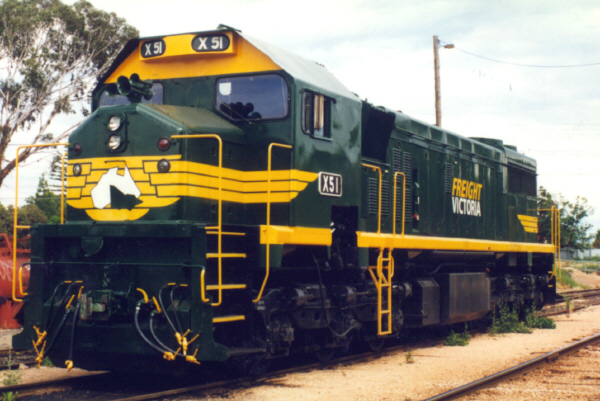
X51 in its new color scheme and carrying the name of its new owner, Freight Victoria. Mildura 8-12-1999. Photo: Bruce McLean
On 1-3-2000 Freight Victoria changed its name to Freight Australia to reflect the contracts that has been picked up in New South Wales to move log and grain traffic.
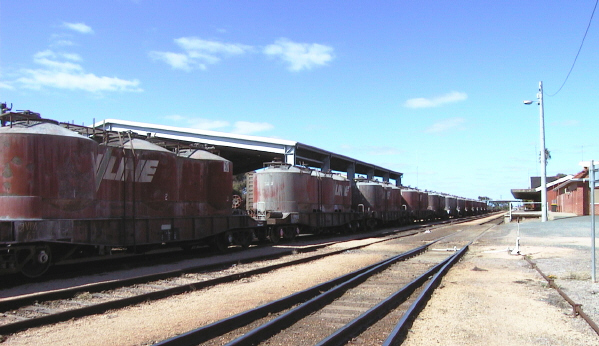
A substantial component of inwards traffic on the Mildura corridor is bulk cement for Blue Circle Cement. The number of wagons in the Mildura yard indicates the extent of traffic on 22-4-2000. Photo: Brian Evans
By early January 2001, Freight Australia changed the marketing brand of its Less-than-Container-Load business from "Fast Track" to "General Freight".
The cement works at Fyansford were closed in March 2001. The last two wagons of gypsum forwarded from Cowangie were received at Gheringhap (where road transport was used to transfer the gypsum) on 16-3-2001. Gypsum for Waurn Ponds continues to be regularly sent by rail from Cowangie.
The end of Freight Australia's second year of operation (May 2001) saw a huge financial turn-around for rail freight in Victoria. Freight Australia's maiden full year earnings before interest, tax, depreciation and amortisation was $45 million, a $57 million turnaround in 20 months. Revenue was lifted from $100 million to $184 million aided by bumper grain harvests and new interstate and transcontinental operations.
In June 2001, Freight Australia applied to the National Competition Council for declaration of the Victorian country rail network under the principles of Part IIIA of the Commonwealth Trade Practices Act. The move was prompted by Freight Australia's opposition to the Brack's Government's open access regime that came into effect on 1-7-2001. The company maintained that the pricing arrangement for the state's access regime did not allow it adequate return on its investment of $90 million it paid for the track, enabling competitors to operate more cheaply and "cherry pick" the most profitable rail lines. Freight Australia wanted a national access regime to operate in line with the Australian Rail Track Corporation which controlled the interstate rail tracks.
RailAmerica, the parent company of Freight Australia, banned the further upgrading of 3,000 km of leased track in Victoria.
Construction of the Alice Springs to Darwin railway commenced on 17-7-2001 with an official first-sod ceremony. On 18-7-2002, the former Deputy Prime Minister, Mr. T. Fischer, an ambassador for the new railway, addressed the Australian Dried Fruits Association Federal Council at Mildura. Mr. Fischer pointed out that the new railway would shorten delivery times by seven days for fresh fruit exports from Sunraysia into South East Asia. With standardisation of the Mildura and Ouyen to Pinnaroo lines, containers of fresh fruit would remain on rail from Mildura to Darwin where they would be transferred to ships. Mr. Fischer said 20% of Port of Melbourne containers go to Singapore and it would take only a small percentage of this traffic, including produce from Mildura, to make the new Darwin railway viable.
The Group Manager of Wakefield's Transport, Mr. K. Wakefield, was appointed to the new Victorian Rail Freight Advisory Council in October 2001. The Minister for Transport, Mr. P. Batchelor, would be looking to the council for strategic and policy advice on issues about the development, planning, regulation and operation of all aspects of rail freight services in Victoria with particular reference to:
* Improving efficiency and competitiveness within the rail transport industry;
* Encouraging harmonisation of operational and safety practices;
* Increasing the mode share of rail in Victoria;
* Competitive neutrality, including pricing, regulation and investment; and
* Community and environmental issues.
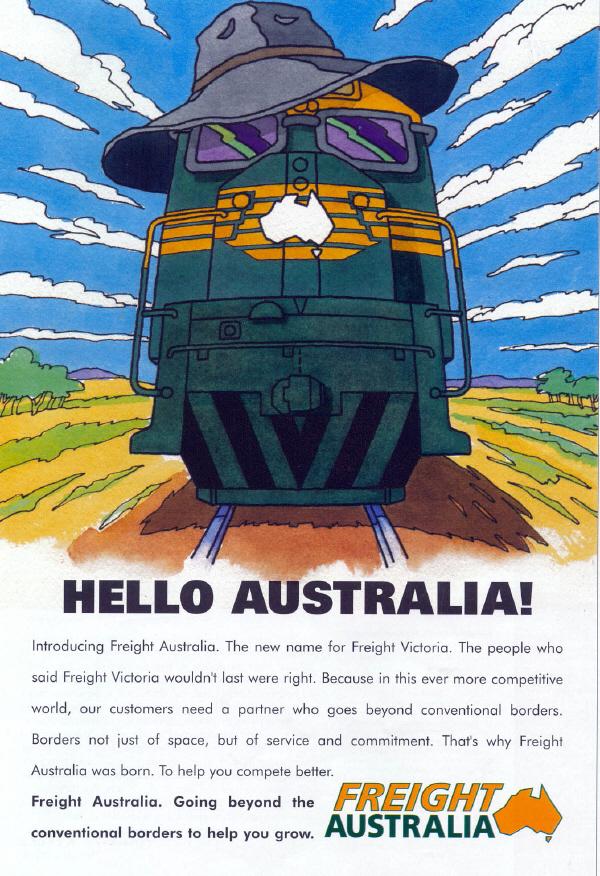
Advertisement published in April 2000 to introduce the change of name for Freight Australia. Source: Track & Signal Magazine
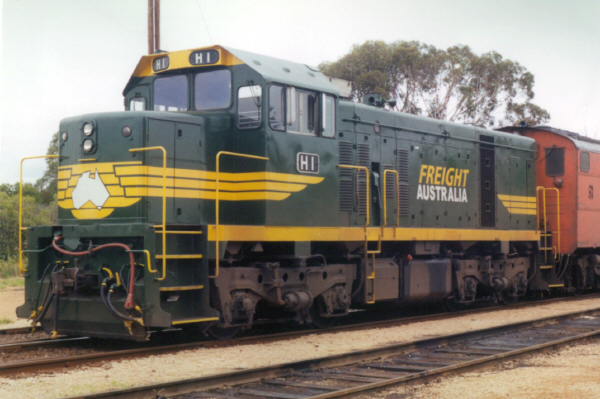
H1 bearing the "Freight Australia" name. Mildura. 8-6-2000. Photo: Bruce McLean
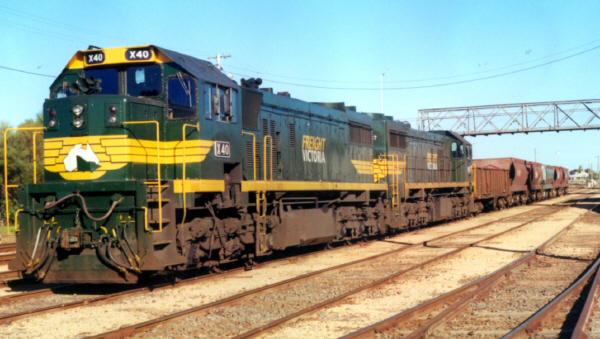
Two green X class locos - X40 and X37 - head up the gypsum train from Cowangie at Ouyen on 16-7-2000. Photo: Bruce McLean
On 11-5-2001 it was announced by the Premier (Mr. S. Bracks) that passenger trains would be returned to country centres that lost their train services under the Liberal/National Party coalition. The Managing Director of Freight Australia (Mr. M. van Onselen), issued a media release stating that the return of passenger services to the Bairnsdale, Leongatha, Ararat and Mildura lines "can only help the long term viability of rail corridors in Victoria".
The following Tuesday, 14-5-2001, the State government announced almost $160 million in freight and passenger rail investments in regional and rural Victoria when it handed down its Budget. The biggest beneficiary was the country rail network with more than $96 million for upgrading and converting a significant portion of the Sate system to standard gauge. In the Mallee, the lines to be converted in 2002 included Dunolly to Mildura and Yelta, and Ouyen to Pinnaroo. In 2004 lines from Dunolly to Korong Vale, Korong Vale to Kulwin and Korong Vale to Robinvale would be converted. Dunolly to Geelong would also be converted to standard gauge in 2002 giving the Mallee standard gauge connection to the ports of Geelong and Portland. The Budget also confirmed the previously announced $7.7 to bring the Geelong to Mildura line up to a higher standard for running passenger trains.
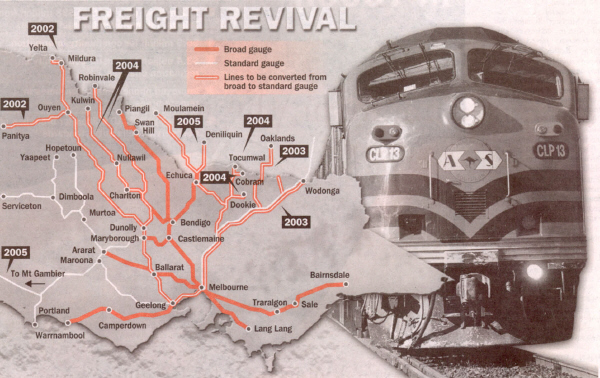
Map produced by the Weekly Times on 16-5-2001 showing the standard gauge conversion plans provided for in the State government's 2001 Budget announced on 15-5-2001.
North Geelong to Mildura and Yelta |
Late 2002 |
For the Mildura line, the announcements were of particular significance as the investment in the tracks would assist major developments in the transport of bulk commodities. AWB Limited had previously announced that it would invest $6.5 million in a 120,000 tonne grain complex at Sea Lake, plus another $6.5 each on similar sized complexes at Birchip and Charlton. There were also opportunities for the movement of mineral sands from the vast deposits identified in the north-west of the State. The Minister for Transport (Mr. P. Batchelor) also indicated in the Budget announcements that the Victorian rail freight system would be opened up for open access competition for rail operators from 1-7-2001. The government timetable for standardisation of the north-west lines was as follows: Ouyen to Pinnaroo |
Late 2002 |
Dunolly to Korong Vale and Robinvale |
Late 2004 |
Korong Vale to Kulwin |
Late 2004 |
The Minister for Transport (Mr. P. Batchelor) visited Mildura on 18-5-2001 to meet with representatives from the mineral sands industry. The Minister briefed the industry on how standardisation would benefit the industry, the time lines over which it would apply and how the industry could contribute to the finalisation of the program to meet the industry's production needs and the world market.
In October 2001, the Transport Minister, Mr. P. Batchelor, announced that he had formed the Victorian Rail Freight Advisory Council and had appointed Mr. K. Wakefield, Group Manager of Wakefield Transport, Merbein as a member. The "Regional Freight Links Program" would advise on initiatives including rail gauge standardisation, construction of the Albury-Wodonga rail by-pass, improved rail-port links including creation of standard gauge access to the Geelong Grain Loop as well as the introduction of on-track competition via a rail access regime. The government had also set up a Victorian Road Freight Advisory Council and Victoria Sea Freight Advisory Council.
The growth of rail freight on the Mildura corridor by 2002, particularly from traffic emanating from Merbein, can be contributed to the innovative intermodal practices adopted by the progressive Wakefield's Transport organisation. The daily goods trains into and out of Mildura/Merbein run at their maximum length and in April 2002, it became necessary for an additional locomotive to be added to the train to maintain scheduled times.
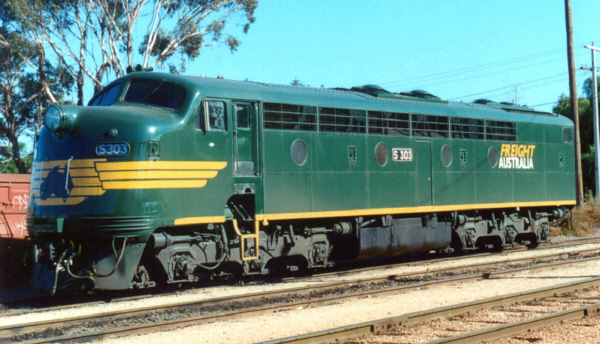
S303 was leased to Freight Australia by its owners, the Seymour Railway Heritage Centre, to make up for a shortage in large horsepower locomotives. On 14-5-2002, S303 was at Mildura on second engine duties. Photo: Bruce McLean
The Merbein intermodal container terminal operated by Wakefield Transport under their Ironhorse Intermodal Division, established in 1994, had grown its throughput of containers from 120 in the first year of operation to 9,500 per annum in 1998.
Rail was used for all export containers which originated from Sunraysia, the South Australian Riverland and South Western New South Wales. They pass through the Port of Melbourne to be shipped overseas.
Road is used to transport domestic containers due to Mildura not being directly linked to the standard gauge network.
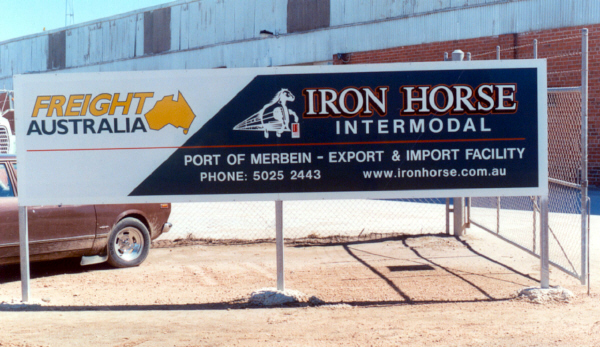
Sign telling the story of the Wakefield Transport operation linkage to Freight Australia at the entrance to their Merbein headquarters. 14-4-2002. Photo: Bruce McLean
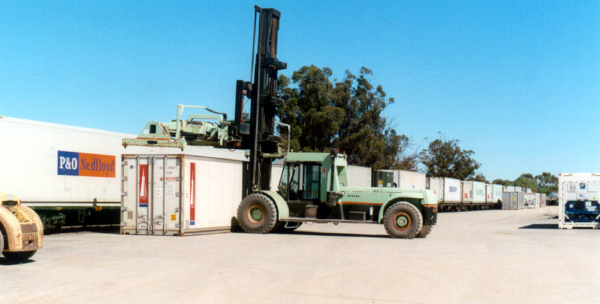
Forklift handling containers at Wakefield Transport intermodal depot at Merbein. 14-4-2002. Photo: Bruce McLean
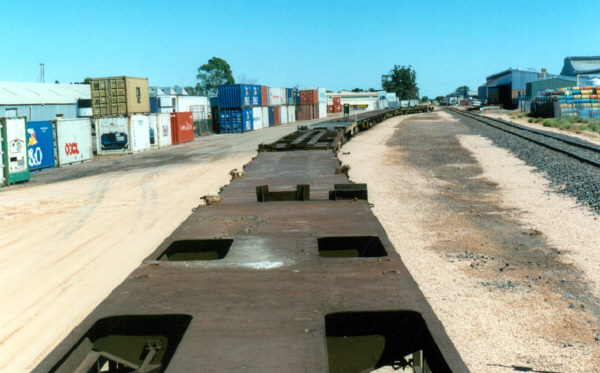
Freight Australia changed container charging arrangements with the result that Wakefield Transport developed a container storage area on the railway reserve at Merbein between the up end of the loop siding and the Aurora Packing Co. shed. In April 2002 the area was sealed to provide a significant container storage area. In this view we see containers stored parallel to the loop siding and empty container flat wagons ready for loading. 14-4-2002. Photo: Bruce McLean
The North West Freight Transport Strategy was released in May 2000. The strategy was drawn up by the Department of Infrastructure in consultation with Vicroads, the Mildura and Swan Hill municipal councils and the North West Municipalities Association.
Priority actions identified included:
* Standardisation of the north-west rail lines;
* Upgrading the Mildura line to Class 2 for the purpose of passenger rail operation and assess suitability of lifting rail freight train speed limit;
* Negotiations between South Australian and Victorian governments, Freight Australia and Australian Southern Railroad to resolve the timing of developing a rail connection between Panitya and Pinnaroo;
* Mildura Rural City Council to consider Redcliffs inter-modal facility, include in industrial framework and Municipal Strategic Statement and protect access to track;
* Mildura Rural City Council includes site for relocated Mildura Freight Gate in Framework Plan and move to protect access to rail reserve;
* Mildura Rural City Council decides preferred petroleum relocation site and factor into industrial land planning framework/Municipal Strategic Statement.
Strategic actions, in addition to the above included:
* Increase strategic passing loop lengths to permit longer freight trains;
* Government and council actions to support expansion of the Merbein inter-modal facility as a regional resource;
* Protect option for an inter-modal facility at Redcliffs serving bulk loading of mineral sands and containers supplementing the Merbein facility or alternatively, reinstate a spur line between Redcliffs and Thurla along former Morkalla line reservation;
* Retain north-west grain lines and maintain to existing standards;
* Relocate the Mildura Freight Gate facility from the Mildura waterfront. The new location would be preferably located east of Benetook Avenue and west of Cowra Avenue. Negotiations with stakeholders to resolve access arrangements and land matters should begin. This will permit development of Sunraysia 2000 proposal and rationalisation of existing rail facilities at the Mildura station site;
Mildura Rural City Council to protect land for a consolidated petroleum storage and distribution centre, including suitable zoning and protection from future residential and commercial encroachment. Two site options have been identified including the current Caltex siding or a co-location with the relocated Mildura Freight Gate.
The Minister for Transport, Mr. P. Batchelor, said that the strategy would maximise the use of transport infrastructure already in place in the area. He also stated "by identifying sources of future growth in regional production, the North West Freight Transport Strategy has determined that the area's current rail and road network has ample capacity for projected freight requirements for the next ten years. The strategy identifies initiatives to better use existing infrastructure, by developing new and enhanced inter-modal facilities, removing barriers to the efficient movement of freight, and increasing the use of rail for long distance freight shipments".
On 18-6-2002, the Minister for Transport advised that rail standardisation progress was underway, however there would be a delay in the conversion of the Mildura line. Following discussions with industry, the first stage of track conversion on the Mildura line would be delayed until early in 2003 in order to deliver effective outcomes that do not disrupt Victoria's major export industry cycles (grain harvest). The Minister also alluded to environmental approvals from the Federal government (there are about 30 environmentally sensitive sites between Geelong and Mildura).
Standard gauge works in progress included the awarding of twelve contracts for project elements such as design, project management, survey work and provision of various track materials. Works included track rearrangement works at Dynon, Tottenham and North Geelong, dual gauging works at Brooklyn and Sunshine rail yards, construction of the Corio independent goods line and siding alterations at Corio and North Shore.
In June 2002, the Managing Director of Freight Australia, Mr. M. Van Onselen, released a document titled "Moving Ahead - A Plan for Better Rail Freight in Victoria". The plan was presented to the government and it now remained for the Minister for Transport to decide on the future approach to upgrading and standardisation of the Mildura line. Key pages from the document are reproduced herewith:
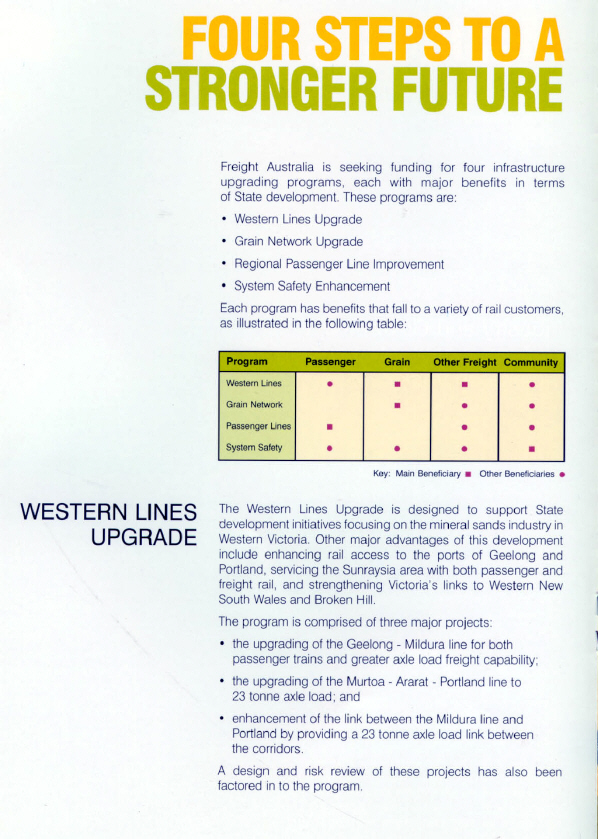
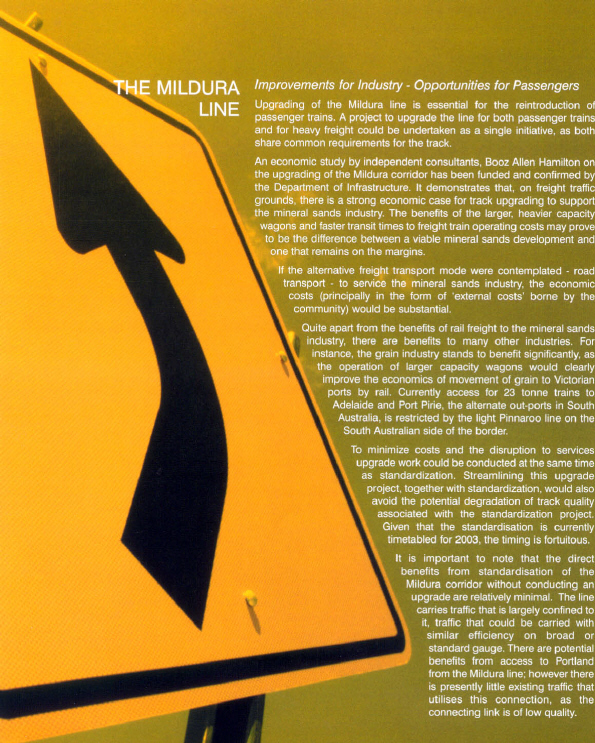
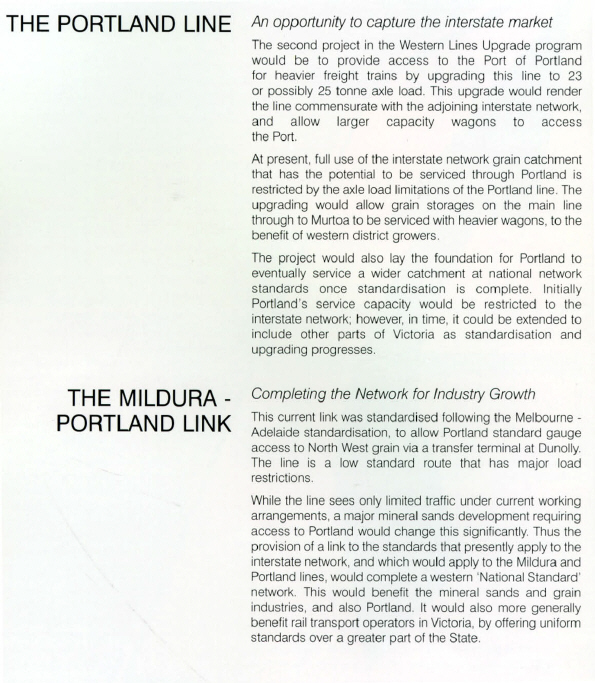
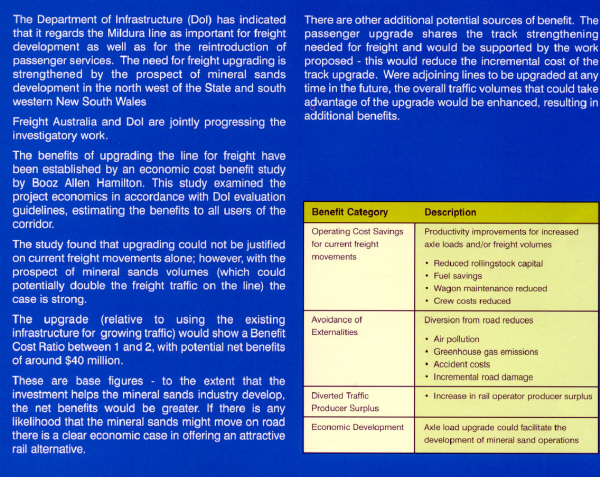
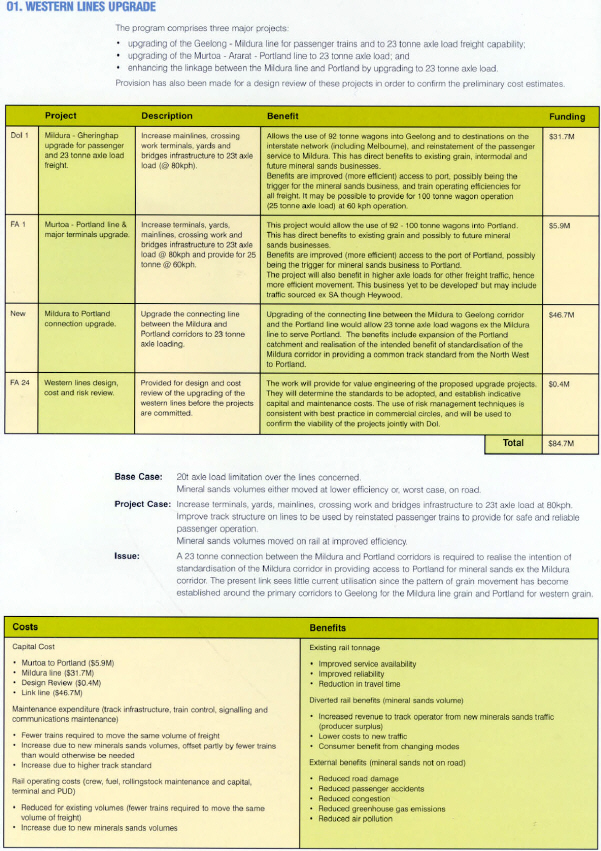
From Freight Australia "Moving Ahead - A Plan for Better Rail Freight in Victoria" - June 2002. Source: Freight Australia
In August 2002, Freight Australia commenced a program of repainting their Fast Track containers - each promoting a container service destination.
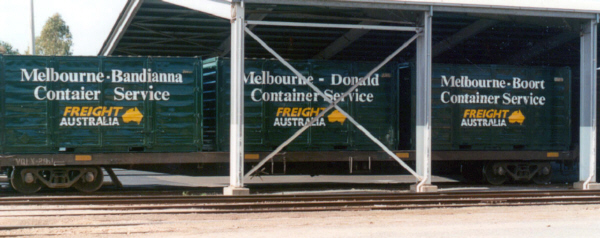
Containers in the new Freight Australia image. Note the spelling of the words "container" and "Bandiana" on the left hand container. It was later corrected. Mildura 22-8-2002. Photo: Bruce McLean
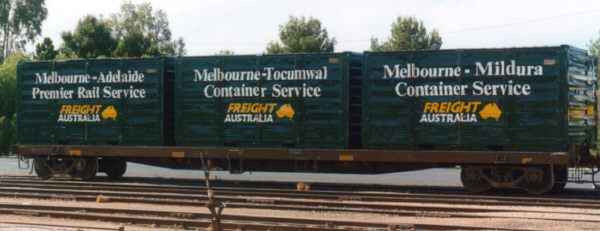
The Melbourne - Adelaide container service was billed as "Premier Rail Service". Mildura 22-8-2002. Photo: Bruce McLean

Containers marked for Echuca/Deniliquin, Portland and Sydney services. Mildura 21-8-2002. Photo: Bruce McLean
The $96 million standard gauge project in Victoria was starting to look like a complete mess by March 2003. The first stage of work on the Geelong to Maryborough section of the Mildura line was expected to start in February 2003 with trains transferred to the Bendigo line whilst regauging took place between Geelong and Maryborough.
The Victorian Farmer's Federation Grains Group met with the Department of Infrastructure in March 2003 and reported that the department had refused to set a time frame for the start of standard gauge conversion. The VFF Grains Group expressed concern that the government would start work on the Melbourne to Bendigo fast train project, effectively blocking and rail freight diversions from the Geelong to Maryborough section. The Bendigo project would involve dislocation of services on that line for about nine months.
In the meantime, traffic continued to operate regularly with the Sunday to Friday daily express goods to and from Mildura. Grain trains were running to Yelta and Panitya as required and at least 14 wagons of gypsum was being sent from Cowangie each week to Waurn Ponds.
The $96 million standard gauge project in Victoria was starting to look like a complete mess by March 2003. The first stage of work on the Geelong to Maryborough section of the Mildura line was expected to start in February 2003 with trains transferred to the Bendigo line whilst regauging took place between Geelong and Maryborough.
The Victorian Farmer's Federation Grains Group met with the Department of Infrastructure in March 2003 and reported that the department had refused to set a time frame for the start of standard gauge conversion. The VFF Grains Group expressed concern that the government would start work on the Melbourne to Bendigo fast train project, effectively blocking and rail freight diversions from the Geelong to Maryborough section. The Bendigo project would involve dislocation of services on that line for about nine months.
Mr. M. Van Onselen, CEO of Freight Australia had earlier asked the VFF Grains Group to use its "considerable voice and influence to get behind an upgrade of the rail lines, which have not changed since the 1950's".
In the State parliament on 20-3-2003, the Leader of the National Party, Mr. P. Ryan, asked the Minister for Transport (Mr. P. Batchelor) "that given that it is now two years since the Government announced its standardisation program, will the Minister give definitive date for the commencement of works?". The Minister responded by saying he could "advise all members that for our standardisation program to proceed, we have to finalise arrangements with the operator, the controller of the Infrastructure, Freight Australia". He said the key issue in progressing standardisation was the fact that the rail network was leased to Freight Australia by the previous Liberal government and this gives it control over the network and considerable control over the timing of upgrades to the track. Mr. Batchelor told the parliament "The government and Freight Australia are continuing to have constructive discussions on this issue.".
Member for North Western province, Mr. B. Bishop, continually pressed the government for a definitive starting date and on 25-3-2003, responded to rumours that the Labor party planned to shelve standardisation and an upgrade of the Mildura line by saying that this was not acceptable. Mr. Bishop supported the view that standardisation would benefit the whole of Victoria and provide the most efficient and advantageous freight system. Mr. Bishop also suggested that the government should negotiate out of the track lease with Freight Australia.
Member for Mildura, Mr. R. Savage, also entered the debate by claiming that "Freight Australia (Rail America) had been blocking the initiative from day one". Mr. Savage claimed "I am not privy to these discussions between the government and Freight Australia but the time has passed for allowing any recalcitrant behaviour by Freight Australia. The government must take control of the situation and resolve the current impasse immediately".
The Leader of the National Party, Mr. P. Ryan, stated on 2-4-2003 that the government knew before it announced the standard gauge project that it would have to negotiate with Freight Australia to get the project completed just as it had successfully negotiated with the same company to allow it to proceed with the Fast Rail Links Project and the return of passenger trains to Mildura, Bairnsdale, Ararat and South Gippsland. He asked "if the privatisation contract is to blame, why was it able to get agreement on these two other rail projects?"
The Local Government Rail Alliance, representing 24 local municipalities, met with the Minister for Transport in Melbourne on 10-4-2003 to try and determine when the standard gauge and upgrade rail projects would begin. Mayor of Mildura, Cr. P. Byrne, told the author that it appeared the standard gauge program was not proceeding. This was confirmed on 15-4-2003 when the Parliamentary Secretary for Infrastructure, Mr. C. Carli, in opening the new transport interchange at Mildura railway station, announced that the Mildura passenger train service due to return in late 2004 would probably be on broad gauge. The standard gauge project was subsequently referred to as "postponed" and "deferred" in various government announcements.
The author received private advice from an independent source that the standard gauge program was being held to ransom by Freight Australia who wanted compensation and a guarantee of funding to replace any operating loss for allowing access onto Victoria's standard gauge network by other operators challenging for business. This has not been confirmed, however it were to have elements of fact, it was obviously a set of conditions no government would be prepared to agree to.
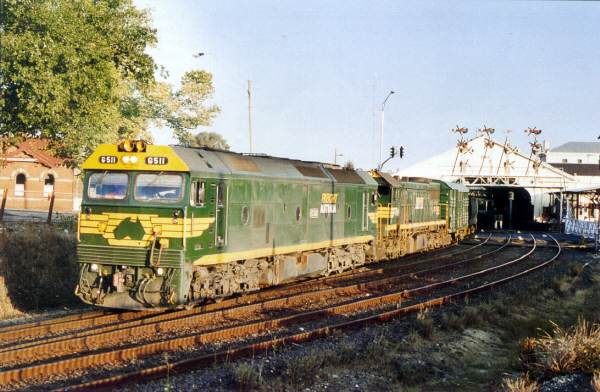
Class leader G511 and X54, the last X Class in service, with 9121 Down Ouyen goods departing from Ballarat on 6-2-2003. Photo: Jeff Bounds
Government representatives from three states - Victoria, New South Wales and South Australia - agreed to the first step in establishing a multi-modal transport hub in the region surrounding Mildura. The meeting was arranged with the Sunraysia Mallee Economic Development Board and discussed policies, regulations and rules and is aiming to bring cross-border barriers down. Dr. P. Crawley, Development Board Chief Executive Officer, said there was consensus among participants for the Ouyen - Pinnaroo - Adelaide rail line to become a major arterial rail line but the Victorian side required standard gauge conversion and upgrading and the South Australian government prepared to convert the 5.6km gap between the border and Pinnaroo.
Dr. Crawley also addressed a Mildura Freight Forum on 17-7-2003 advocating a national rail link from Melbourne to Darwin, passing through Mildura. Dr. Crawley said the "National Inland Rail Link" proposed by the Sunraysia Mallee Economic Development Board included an upgrade and realignment of the track around Mildura and a new line from Mildura to Darnick and would cost $450 million. This compared with other proposed lines as follows:
* Melbourne-Sydney-Brisbane-Mt.Isa-Darwin, $1.7 billion;
* Melbourne-Parkes-Mt.Isa-Darwin, $1.2 billion.
Dr. Crawley described the proposal as "a Melbourne to Darwin line via Sunraysia overlaying the Tri-State macro cluster". He claimed it worked well with plans for a multi-modal hub at Mildura linking road, rail and air freight and passenger services and would provide a base for creating economies of scale and therefore the best rates for producers and manufacturers to export to Asia.
| << Back | Home | Site Map | Copyright © 2003 Bruce McLean, All Rights Reserved |